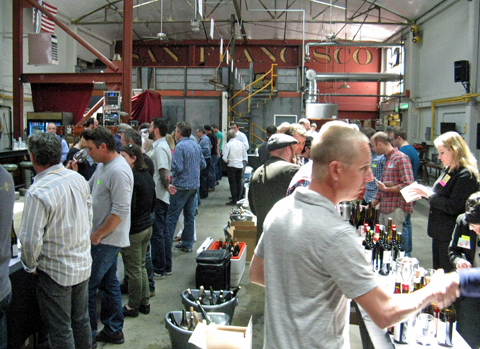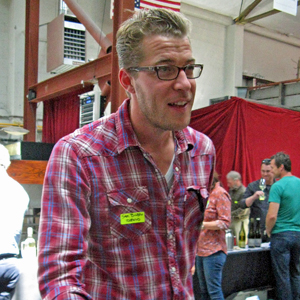Third Annual Seven % Solution Tasting – May 6th, 2015
I attended the Seven % Solution Tasting in early May, and wrote a report for the Grape-Nutz.com website. A portion of the report is below – there are more comments, photos, and tasting impressions of over 75 wines from 21 producers here (a little different format for tasting impressions than what I’ve done in the recent past):
Third Annual Seven % Solution Tasting – May 6th, 2015

Report on the third annual Seven % Solution Tasting, held on Wednesday May 6th, 2015, at Folsom Street Foundry in San Francisco. The event showcased wines made from California’s less widely-planted grape varieties.
As it has been from the start, the Seven % Solution tasting was presented by Bergamot Alley wine bar in Healdsburg. The Wednesday tasting I attended comprised an afternoon trade / media tasting with a public tasting in the evening – a second public tasting was held at Bergamot Alley on Saturday May 9th. According to the information provided by the event organizers, just eight grape varieties comprise about 93% of winegrape acreage planted in Northern California – the idea of this tasting was to highlight the other 7%, many of them lesser-known varieties.
Overall Impressions
There were 25 producers pouring their wines at the Seven % Solution tasting at Folsom Street Foundry – fewer producers poured a few days later at the smaller Bergamot Alley venue. The line-up of wineries who have participated in this event has changed a little since their first event in 2013, but the majority of the group has remained, and the larger San Francisco venue has allowed them to add more producers for that day’s tastings.
I had planned to only attend the afternoon trade / media tasting, but the day before the event Steve Edmunds asked me to help him pour at the evening tasting. I help Steve from time to time at the facility where he makes one of his wines in Berkeley, so to avoid any appearance of conflict of interest, I have not included my tasting impressions of the Edmunds St. John wines, only some general notes about them. Staying for the evening tasting did give me the opportunity to get out from behind Steve’s table for a bit to taste the wines from a few more producers – a nice bonus since I’d arrived later than expected for the afternoon tasting due to transit problems that day.

With more producers participating as compared with the inaugural event two years ago, there was noticeably greater breadth, both in terms of winery locations (some producers from the Sierra Foothills and Central Coast this time) and grape varieties (more specialists in Italian varieties and producers dedicated to Iberian and Alsatian varieties). This was great work by the event organizers to add wineries such as these, and the larger Folsom Street Foundry space made it feasible. There were several wineries pouring at this year’s event that were new to me, and I managed to try all but one of them. Thanks in part to being able to spend unexpected extra time trying a few wines during the evening tasting, I managed to sample wines from 22 of the 25 producers pouring at the event.
Some of the grape varieties showcased at this tasting are truly rare in California, such as Lacrima, Schioppettino, and Verdicchio. A few that were nearly as rare only a few years ago, such as Gamay Noir, Ribolla Gialla, and Trousseau, are being planted on a still-small but increasing scale. Other varieties were once fairly common in the state but are no longer seen nearly as much, such as Trousseau Gris (once known as Grey Riesling) and Valdiguié (once known as Napa Gamay). Still other varieties represented at the tasting are in fact planted on a significantly wider scale, such as Pinot Gris/Grigio, Barbera, and Grenache. While Rhône grape varieties may fall within the 7% acreage theme of the event, many of them seem downright commonplace in California these days, some 25-30 years after the “Rhône Rangers” movement first blossomed, but there were plenty of more-unusual grapes to be explored at the tasting.
The producers if these wines deserve credit for taking chances on lesser-known grape varieties that don’t bring in as much money as Cabernet and the like. They also deserve credit for seeking out the often-tiny plantings of these grapes, finding older vineyards planted with now-unusual varieties, as well as for convincing growers to take a risk with new plantings of obscure grapes.

Sam Bilbro of Idlewild Wines
The wineries participating in the Seven % Solution tasting share a desire to do something different, and that was clear not only in the choice of grape varieties but in the non-mainstream winemaking techniques that many of them employ. In fact, one could argue that in some cases this tasting showcased those techniques as much as or more than the grape varieties themselves. Skin-fermented whites, whole-cluster fermented reds, carbonic maceration, lengthy extended maceration, use of concrete tanks, etc. – all were on display. And while many of the producers at this tasting shied away entirely from newer oak in their wines, a few others demonstrated that a percentage of new oak can work very well with some of these varieties if it is handled appropriately to keep it in balance.
My list of Favorites for the tasting includes a broad range of varieties, with a nearly-even split between reds and whites/Rosés. The one variety that did stand out as having more than its share of Favorites for me this year was Mourvèdre – great showing for that grape and a fine job by those producers working with it! Although I found wines I really enjoyed from just about every producer I tried, some of them stood out – Dirty and Rowdy, Donkey and Goat, Giornata, Idlewild, La Clarine Farm, Ryme, Two Shepherds, Unti, and Wind Gap poured particularly impressive wine line-ups. As I found in the previous Seven % Solution tasting I attended, a fair number of wines had been bottled within the few months (and in some cases a very short time) before the event, so at least a little additional time in the bottle should help them to show their best. And as I’d also found before, many of these wines are meant to be enjoyed in the short term – fun wines that you can drink now rather than waiting years before they’re ready to go.

I’ve mentioned before that one of the great things about checking out all these less-common grape varieties is that there are actually quite a number of California producers working with them, so the producers at this tasting really represent just the tip of the iceberg. For example, there were few wines made from Spanish and Portuguese varieties being poured, and there are many fine ones produced in California these days – hopefully we’ll see more of them at future Seven % Solution tastings. You’ll find growers and producers – mostly smaller ones – in all corners of the state who are doing very good work with these lesser-known varieties, and the quality of the fruit and the wines just keeps getting better.
I greatly enjoyed the Seven % Solution tasting at Folsom Street Foundry. I’d missed last year’s event due to a schedule conflict so I was really looking forward to returning this year, and the tasting did not disappoint. I can’t recommend the Seven % Solution tasting highly enough – if you have a chance to attend next year, be sure not to miss it. This was not the most profound group of wines I’ll taste this year, but it may well have been the most fun!
Favorites
Whites, Rosés, and Sparkling
Arnot-Roberts 2014 Touriga Rosé
Donkey and Goat 2014 “Isabel’s Cuvée” Rosé
Giornata 2014 Vermentino
Idlewild 2014 Arneis
La Clarine Farm 2014 Albariño
Leo Steen 2012 Jurassic Vineyard Chenin Blanc
Ryme 2014 “Hers” Vermentino
Ryme 2013 Fiano
The Scholium Project 2014 “Blowout” Sparkling
Stark 2013 “Three Vineyards”
Two Shepherds 2013 Grenache Blanc
Wind Gap 2014 Trousseau Gris
Reds
Bedrock 2013 “Ode to Lucien”
Dirty and Rowdy 2014 “Familiar” Mourvèdre
Dirty and Rowdy 2013 Antle Vineyard Mourvèdre
Donkey and Goat 2013 “The Prospector” Mourvèdre
Giornata 2012 Luna Matta Vineyard Aglianico
Idlewild 2012 Nebbiolo
La Clarine Farm 2014 “Jambalaia Rouge”
Lioco 2013 Valdiguié
Matthiasson NV Schioppettino
Two Shepherds 2012 Mourvèdre
Unti 2012 Montepulciano
Unti NV Lacrima
Wind Gap 2014 “Soif”

Tracey Brandt of Donkey and Goat Winery